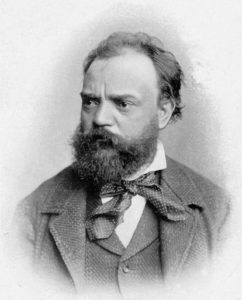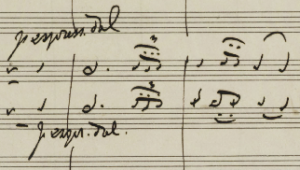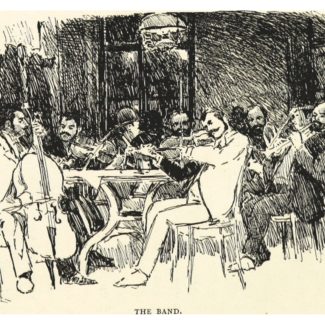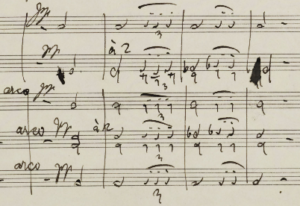In October 1883, Antonín Dvořák wrote to his publisher: “I was recently in Vienna, where I spent very fine days with Dr. Brahms, who had just come back from Wiesbaden,” a picturesque town on the Rhine river in Western Germany. The Czech composer, a good friend of Brahms, continued:

“You know, of course, how very reticent he is even to his dearest friends and musicians in regard to his work, but towards me he was not so. At my request to hear something of his new symphony, he was immediately forthcoming and played its first and last movements for me. I say without exaggerating that this work surpasses his first two symphonies; if not, perhaps, in grandeur and powerful conception—then certainly in—beauty. […] What magnificent melodies there are for the finding!”
Dvořák was not alone in his enthusiasm; upon the symphony’s premiere the following December with the Vienna Philharmonic, the work was embraced by audiences and critics alike and has remained a cornerstone of the repertoire ever since. The fifty-year-old composer was at the height of his powers, and in addition to the many beautiful melodies that Dvořák noted, his new symphony also displayed vibrant orchestral colors and an ingenious rhythmic and metrical flexibility. The shortest of his four symphonies, it remains a prime example of the musical economy and organic development which Brahms had long cultivated.
A Secret Musical Code?
But beneath the symphony’s technical perfections lie powerful emotions. Though Dr. Brahms liked to hide behind a professorial mask of craftsmanship and tradition, he was at heart a Romantic. The symphony traces a dramatic narrative arc, and its cyclical technique—in which melodies from earlier movements “cycle back” in later movements—was at the time more characteristic of program music than abstract symphonic music. The guarded Brahms always publicly denied any extra-musical inspiration for his instrumental works, although on rare occasions he gave his friends tantalizing clues about his true sources of inspiration. Regarding the Third Symphony, he said nothing, although scholars have identified a few intriguing musical allusions in the score that suggest that the work was a deeply personal one.
The symphony begins with three powerful chords that underscore the notes F-A-flat-F:
Virtually all of the melodic ideas in the symphony are related to this simple musical motif. The notes are a variant of Brahms’ famous F-A-F “motto.” Brahms’ friend and biographer Max Kalbeck identified F-A-F as a musical cipher for “frei aber froh”—“free but happy”—which was Brahms’ response to his friend Joseph Joachim’s F-A-E, which stood for “frei aber einsam”—“free but lonely.” Both of these can be found in other works (such as the A minor string quartet and the early F-A-E violin sonata, which was composed collaboratively by Brahms, Schumann and Dietrich for Joachim to play).

Brahms’ “frei aber froh” motto reflected his uncompromising need for independence in both his professional and personal life. Though he came close several times, he never married, possibly due to unresolved feelings for Clara Schumann, the disintegration of his parents’ marriage, a fear of being hindered in his work by having to provide for a family, or a simple fear of commitment. Instead, his typical pattern involved a series of intense but platonic crushes on intelligent, beautiful young singers and regular patronage of Vienna’s brothels, whose employees reportedly appreciated his kindness and generosity. Many biographers have also speculated that his purported youthful experiences of supplementing his family’s limited income by playing piano in Hamburg’s red light district may have influenced his relationships with women, although some dispute the claim that he performed in any disreputable establishments. He maintained a close circle of friends throughout his life, but rarely revealed his innermost thoughts and feelings, even to them. It was only though the inscrutable language of music that he gave full expression to his inner world.
The three notes that begin the symphony are not F-A-F, though, but F-A-flat-F. Though the key of the symphony is F major, the note A-flat belongs to F minor, and imbues the opening with a sense of conflict and instability. Indeed, the conflict between F major and F minor will drive the entire symphony, only reaching resolution in its final pages. For Brahms, could this alteration have symbolized doubt or conflicted feelings about his “free but happy” motto? Perhaps, but he may have made the change for purely musical reasons as well.
Memories of the Rhine
The third chord also introduces the dynamic main theme of the first movement. Brahms’ stay in the Rhineland must have brought back memories of his formative years with the Schumanns in nearby Düsseldorf. The main idea that forms the basis of this melody is actually a quotation from a passing phrase in Schumann’s Rhenish Symphony, and its rushing, surging character recalls the opening of the same piece. While Schumann’s opening seems to be an uncomplicated, enthusiastic celebration of the famous river, Brahms’ “Rhine” theme is by contrast more laden with a tense, powerful energy: the music lunges back and forth between F major and F minor, realizing the conflict implied by the opening chords. The result is a thrilling, unforgettable beginning.
Soon after, the music broadens and calms as it transitions to the second theme. Just before it appears, Brahms includes an allusion to the music of Wagner, who had died just months before Brahms wrote the symphony. The harmonies just before the second theme arrives are adapted from the “Siren’s Chorus” from Tannhäuser, in which beautiful women sing “Approach the shore! Approach the land, where, in the arms of glowing love, let blissful warmth content your desires!” Although contemporary critics had often pitted Brahms and Wagner against each other as arch rivals, Brahms actually admired Wagner’s music, and even owned part of Wagner’s handwritten manuscript to Tannhäuser for a time (Wagner was dismayed when he found out it had fallen into Brahms’ hands and concocted a plot to get it back). Is this Wagner reference a hint at some secret program or merely a nod to an admired contemporary who had recently passed away? It could also be a simple coincidence, but given that Brahms owned and certainly studied Wagner’s manuscript, that seems unlikely.

Another consideration that makes the reference to Wagner’s “Siren’s Chorus” intriguing was Brahms proximity to the Lorelei rock, a famous cliff on the Rhine just downstream from Wiesbaden. It is likely that the scenery-loving Brahms visited it during his stay, and he was certainly familiar with the legend that the rock was the home of Lorelei, a beautiful, siren-like water spirit that lured passing fishermen to a rocky death with her enchanting song. The legend was perhaps most famously evoked in a poem by Heinrich Heine, which was in turn set to music by Franz Liszt. Compare this bit of Liszt’s song with the new theme that Brahms introduces immediately after the Wagner allusion. Here, Brahms imperceptibly slips from the 6/4 meter of the opening to the 9/4 meter of Liszt’s song, effectively adding a beat to each measure and further relaxing the music. Following a shape similar to that of Liszt’s melody, this lyrical tune for clarinet unfolds naturally and organically above a steady drone bass, giving the music a pastoral atmosphere. Each measure is a variation of the one before, as if the clarinetist is improvising, or noodling on a brief idea. Could this melody represent Lorelei’s song?
The melody is then taken up by other instruments, but soon unravels as the music darkens, transitioning to A minor. Interestingly, at this moment the “frei aber froh” motif reappears in the oboe. The music also returns to the original 6/4 meter, but the rhythms become increasingly unstable, full of syncopations and unexpected accents. The gathering storm disperses as the music suddenly falls down another major third, back to F major and the opening of the piece. Following classical tradition, the music repeats up to this point, giving listeners the chance to become more familiar with the main ideas of the movement.

When the stormy music returns, it leads to a transformed version of the “Lorelei” theme, which becomes passionate and emotionally intense. After this agitato episode, the music calms as a solo horn intones a warm, extended version of the “frei aber froh” motif. Fragments of the Rhine theme return low in the orchestra, leading to reprises of the Rhine theme and the “Lorelei” theme. The Rhine theme then begins a thrilling coda that dies away to a quiet ending.
The second movement begins in C major with another lyrical melody for clarinet that many have likened to a German folksong. The chorale-like texture of the accompaniment also recalls traditional hymns; indeed, Clara Schumann declared that this movement was “a pure idyll; I can see the worshipers kneeling about the little forest shrine, I hear the babbling brook and the buzz of insects….” Each phrase of the clarinet melody ends with a figure that is echoed in the lower strings; its shape strongly recalls the “frei aber froh” motif, and the contrasting instrumentation suggests a sort of musical conversation between two characters. The melody ends in a blossoming transitional passage that leads to a contrasting second theme. This melancholy, harmonically wandering melody for clarinet and bassoon leads to a strange series of chromatic chords. An increasingly intense development ensues, after which the opening theme returns in such a way that it is nearly impossible to say where the theme begins—a remarkable sleight of hand. Unusually, the melancholy second theme is missing during the reprise of the movement’s themes; in its place is a gorgeous, sunset-like passage leading to the return of the strange chromatic chords. The movement ends with the clarinet stretching out the main theme slower and slower over mysterious, chromatic harmonies.
Romani Melodies
The third movement turns from the pastoral, sunshine-filled landscapes of the first half of the symphony to a more urban, nocturnal atmosphere. The C major of the previous movement now becomes C minor as the cellos open the movement with one of Brahms’ most famous melodies: a slow, bittersweet waltz. The violins then take it up, and after a contrasting phrase, the flute, oboe and horn complete it.

Brahms scholar Malcolm MacDonald has suggested that the melody’s ornamentation imitates Romani (gypsy) music. Likewise, its delicate string accompaniment may be inspired by the characteristic figurations of the cimbalom, an instrument typically associated with Romani music. Though Brahms’ love of this style was most famously manifested in his Hungarian Dances, numerous examples of its influence can be found throughout his oeuvre, ranging from the obvious to the subtle. Though this musical style was often associated with Hungary in Brahms’ day, its true roots lay not with Hungarian peasants but with Romani musicians. It could most often be heard played in cafes, pubs and on street corners; some have likened it to the jazz of nineteenth-century central Europe. Brahms likely associated it with the spirit of independence he so valued.
Brahms’ contemporaries also heard the influence of Romani music in the contrasting central section of the third movement. This strange passage in A-flat major features metrically displaced, sliding figures that float through the woodwinds, answered by tender phrases from the strings. The melody then returns, first in the horn, then the oboe, ending with violins.
The finale begins with a dark, unharmonized melody with an exotic, Phrygian sonority centered on the note C (the Phrygian mode is a variant of the minor scale). As the melody unfolds, an accompanimental texture emerges and reveals that the music is in F minor, fulfilling the implication of the “frei aber froh” motif that began the symphony. This F minor, however, is inflected with the augmented seconds of Romani music, as well as evocative orchestration featuring clarinets and cimbalom-like strings.

This theme is soon interrupted by the surprising return of the melancholy theme from the second movement, now as a tenebrous, mysterious chorale. Suddenly, musical lightning bolts based on the opening Phrygian theme rouse the music, which becomes increasingly tumultuous. A heroic, contrasting second theme appears in the cellos and horns, but the music soon darkens with a series of wrenching pauses followed by a sweeping new theme.
Once this stormy music dissipates, the Phrygian theme reemerges quietly in the woodwinds, as if on tiptoe. The music becomes softer and softer, until an eruption of sound signals the return of the mysterious chorale, this time as the powerful climax of the movement. This segues immediately into a wild reprise of the other themes.
The Phrygian melody then returns once more, unwinding and slowing until it slips into F major. The “frei aber froh” motif reappears, leading to the final incarnation of the mysterious chorale in a broad, noble form that seems to finally resolve the symphony’s tonal conflict. Fragments of the Phrygian theme are combined with the “frei aber froh” motif, the last note of which leads to a last surprise: a shimmering return of the Rhine melody. The music dies away, ending the symphony pianissimo. This hushed ending astonished Brahms’ contemporaries; it is possible that no composer had ended a symphony quietly since the 18th century.
What are we to make of this rich, highly suggestive work? Brahms’ musical allusions, quotations, and thematic recurrences seem to beg for some narrative interpretation. While it is possible to speculate, we will never know exactly what these melodies meant to Brahms, though it seems certain that they did mean something to him beyond abstract exercises in harmony, counterpoint and musical form. Though his distaste for narrative programs may in part have been driven by his desire to conceal his innermost thoughts, Brahms also wanted listeners to imagine their own responses to his works. Like musical inkblots, they invite us to discover our own meanings within them. With its serene ending, this symphony offers us the catharsis of intense emotions that find resolution in inner tranquility. —Calvin Dotsey
Don’t miss Brahms’ Symphony No. 3 on November 18, 19 &20! Get tickets and more information at houstonsymphony.org.
This blog was originally published in April 2018.




It’s interesting trying to determine which of Brahm’s musical ideas had symbolic significance, and which were used for purely musical reasons. I would speculate that there may be a mix of both types of ideas in his symphonies. Maybe he was reluctant to state what the music symbolized to him because then he would then have to bring attention to the ideas that were included for purely musical reasons. This would then potentially rob the listener of symbolic meaning that he or she may attach to these ideas that were purely musical for the composer.
Dear Patrick,
Thanks for reading! If you would like to learn more, I would recommend David Brodbeck’s chapter in this book: https://www.amazon.com/Brahms-His-World-Revised-Festival/dp/0691143447
The book is available through the Houston Public Library as well. I hope you get to hear the symphony live this weekend. Andrés and the orchestra were fantastic at the concert last night!
Best,
Calvin Dotsey
Hi Calvin,
Ok, thanks for the book recommendation! It looks like a very interesting book, especially considering that Brahms is my favorite composer. I will be going to hear the symphony play Brahms 3rd symphony tomorrow!
I enjoy reading your articles about the pieces played by the Houston Symphony. I don’t have time to read all of the full books about all of the composers, so reading these articles is a good compromise for me.
Cheers,
-Patrick Gustie